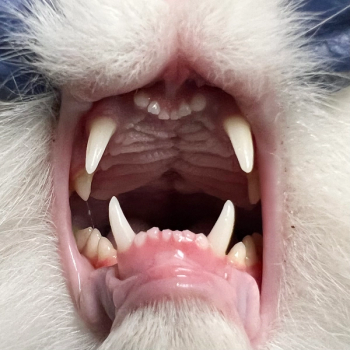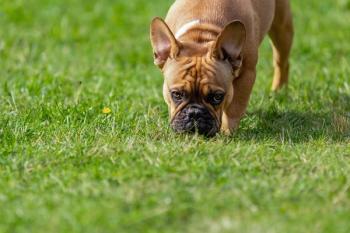
Dental Corner: How to perform a surgical extraction
In May, I explained how to perform a nonsurgical extraction on single-rooted teeth including the incisors, first premolars, deciduous canines, and mandibular third molars. A surgical approach is indicated to extract canines, certain large incisors, and multirooted teeth and to retrieve root tips.
In May, I explained how to perform a nonsurgical extraction on single-rooted teeth including the incisors, first premolars, deciduous canines, and mandibular third molars. A surgical approach is indicated to extract canines, certain large incisors, and multirooted teeth and to retrieve root tips (Figure 1).
Figure 1 1. A German shepherd with a fractured maxillary right canine tooth. This tooth had previously received endodontic treatment as evidenced by the gutta-percha in the pulp chamber (white arrow) and has subsequently refractured near the gingival margin. Further restoration (crown lengthening, post and core build-up) was not elected; surgical extraction is indicated.
Surgical extraction involves creating a mucoperiosteal flap, removing the buccal cortical bone, sectioning the roots in multirooted teeth, elevating the roots individually, performing alveoloplasty, and suturing the extraction site.1-4 Proper extraction technique minimizes complications, reduces the time the procedure takes, and provides you with increased satisfaction (see boxed text titled "General surgical extraction principles").
General surgical extraction principles
EQUIPMENT NEEDS
- Intraoral dental radiography
- A high-speed, water-cooled dental drill powered by compressed air or nitrogen
- A variety of dental burs, including No. 2 and No. 4 round burs in regular and surgical length, to be used with the drill
- An oral surgery pack including a Molt (or similar) periosteal elevator, No. 2 and No. 4 Wiggs winged elevators, a periotome, small-breed extraction forceps, Peet root tip forceps, a hemostat, scissors, tissue forceps, a 5-in Derf needle holder, and lip retraction forceps; an autoclaved pack should be provided for each patient.
- No. 15 scalpel blades, 3-0 and 4-0 chromic gut (or other absorbable) suture material, and Gelfoam (Pfizer Animal Health) or HemaBlock (Abbott Animal Health) to help stabilize the clot
SURGICAL EXTRACTION TECHNIQUE
Step 1: Provide analgesia, obtain pretreatment radiographs, and clean the oral cavity
Before surgical tooth extraction, administer analgesics and perform regional anesthetic nerve blocks to provide preemptive analgesia. Obtain pretreatment radiographs to reveal any hidden pathology, such as root fracture or dilacerations. Perform a dental prophylaxis, and thoroughly rinse the oral cavity with a dilute chlorhexidine solution to prepare the mouth for oral surgery. Try to avoid using a mouth gag because its prolonged use can leave the patient uncomfortable after the procedure.
Step 2: Create a mucoperiosteal flap
Create a mucoperiosteal flap by making two full-thickness incisions (through the mucosa and periosteum) with a scalpel blade starting at the gingival margin on one or both sides of the tooth to be extracted and then extending the incisions apically. The incisions should diverge so that the base of the flap is slightly wider than the gingival margin. Then, use the scalpel blade to incise the epithelial attachment of the flap at the gingival margin. Next, raise the flap with a periosteal elevator (Figure 2).
When using the elevator to create the flap, keep the pressure angled into the bone to incorporate the periosteum in the flap; the flap should contain mucosa and periosteum. Once raised, the flap will expose the buccal cortical bone overlying the tooth root.
Figure2: The same tooth as in Figure 1. A mucoperiosteal flap has been created by making a full-thickness releasing incision (white brackets), and the gingival epithelial attachment has been incised. A Molt periosteal elevator is being used to elevate the flap, starting at the gingival margin; Figure 3: The same tooth as in Figures 1 and 2. The mucoperiosteal flap (white arrow), containing the oral mucosa and the underlying periosteum, has been created and is being reflected to expose the underlying buccal cortical bone (black arrow). A No. 4 round bur operating on a high-speed, water-cooled dental drill is shown ready to remove the bone. Note the color difference between the bone (black arrow) and the tooth; Figure 4: A mandibular right fourth premolar being surgically extracted. A mucoperiosteal flap has been raised, the buccal cortical bone has been removed, and the two roots have been separated by sectioning the crown. These crown-root segments can now be elevated individually.
Step 3: Remove the buccal cortical bone
Once the buccal cortical bone overlying the root is exposed, remove it with a round bur operating on a high-speed, water-cooled dental drill (Figure 3). A water-cooled dental drill is essential to prevent heat necrosis of the surrounding bone. The jugum is the bony prominence overlying the root. Palpating and visualizing the jugum give you landmarks for removing the bone. The root can be identified by its different color. Use the bur with a gentle touch, and keep it moving. For multirooted teeth, it is also helpful to use the bur to expose the root furcation (the area where the root splits). For most surgical extractions, you should remove two-thirds to three-fourths of the buccal bone overlying the tooth root.
Step 4: Section roots (for multirooted teeth)
To aid in extraction, section all multirooted teeth into individual root components by using a round or taper fissure crosscutting bur operating on a high-speed, water-cooled dental drill (Figure 4). To ascertain if the sectioning is complete, place a dental elevator between the sectioned roots and gently rotate it. If the sectioning is complete, the individual roots will move. A working knowledge of tooth root anatomy (or a skull beside the dental workstation) of all multirooted teeth, especially the three-rooted teeth, is essential for making the proper sectioning cuts.3,4
Step 5: Sever the periodontal ligament, and elevate the roots
The individual roots must now be separated from their alveolar attachment. The teeth are attached to the alveolus by the periodontal ligament, so the remaining periodontal ligament must be severed (a portion of the periodontal ligament was removed when the buccal cortical bone was removed).
Insert a dental elevator into the gingival sulcus. Insert the tip or blade of the elevator between the tooth and the alveolar crest, slightly angling it toward the tooth. Establish a purchase by applying gentle pressure apically while also rotating the elevator a few degrees in a side-to-side rocking motion. From this point, rotate the elevator in a motion similar to turning a door handle (Figure 5). Hold the elevator in this rotated position for 10 to 30 seconds, creating tooth movement. Next, find another purchase point and repeat the procedure, again holding the tooth in the distracted position for 10 to 30 seconds.
Figure 5: The same tooth as in Figures 1 to 3. A mucoperiosteal flap has been raised, and about two-thirds of the buccal cortical bone has been removed with a round bur. The round bur was also used to cut a notch in the mesial aspect of the tooth into which a No. 4 Wiggs winged elevator has been placed. Gentle, controlled rotation of the elevator, in a manner similar to turning a door handle, will stretch the periodontal ligament. Sustaining this stretching force for 10 to 30 seconds and repeating this procedure several times will cause the periodontal ligament to fatigue and separate, allowing the tooth to be removed from its alveolus; Figure 6: The same surgical site as in Figures 1 to 3 and 5 after tooth extraction. Alveoloplasty is being performed on the sharp and rough edges.
Repeat this procedure several times to stretch the periodontal fibers to the point of fatigue, at which time the tooth will loosen. Then use appropriately sized dental extraction forceps to grasp the crown near the gingival margin. Gently rotate the tooth along its long axis until it can be removed from the alveolus.
This step is where most root fracture complications occur. Go slowly—taking a few extra minutes to be careful avoids many extra minutes digging out broken root tips. Evaluate each root to be sure extraction is complete.
Step 6: Perform alveoloplasty
Perform alveoloplasty to remove any rough or sharp bony projections in the extraction site, which can negatively affect flap adaptation and the healing and comfort of a mucoperiosteal flap. Alveoloplasty is best accomplished with a No. 4 round bur operating on a high-speed, water-cooled dental drill (Figure 6).
Alveoloplasty is complete when digital palpation of the extraction site reveals no sharp projections. Débride any necrotic debris or other infected tissue from the alveolus, and flush the alveolus with saline or dilute chlorhexidine solution.
Step 7: Suture the extraction site
Suture the extraction site to help stabilize the clot and allow primary healing. The general rules of surgery apply to oral surgery as well, especially that sutures should not be under tension. To relieve tension, fenestrate the periosteum (Figure 7). Be careful not to sever the flap.
Figure 7: The same dog as in Figures 1 to 3, 5, and 6. To relieve tension, fenestrate the periosteum by gently incising the periosteal fibers on the underside of the flap with a No. 15 blade. In 7A, the periosteal fibers have yet to be severed. After periosteal fenestration (7B), the flap is more pliable and can be placed over the alveolus without tension. The white arrows show the border where the periosteum has been fenestrated; Figure 8: Suture fresh-cut epithelium to fresh-cut epithelium. The suture material should be absorbable and not bulky.
Another rule that applies is to suture fresh-cut epithelium to fresh-cut epithelium. Freshen the epithelial edges to be sutured with a scalpel blade or scissors. For oral surgery, the suture material of choice should be absorbable and not bulky. Good choices are 4-0 chromic gut and 4-0 Monocryl (Ethicon) sutures (Figure 8).
Postoperative radiography is unnecessary unless complications occur. Complications can include root tip, alveolar bone, or mandibular fracture; excessive hemorrhage; iatrogenic trauma to adjacent tissues caused by a misdirected dental elevator; oronasal fistula formation; and alveolitis.
Step 8: Provide aftercare
If antibiotics are indicated because of infection, administer them for five to 10 days after surgery. Analgesics are essential and based on the anticipated amount of pain. Instruct owners to provide patients with only soft food and to avoid giving patients hard chew toys for several weeks. A recheck examination of the extraction site in two or three weeks is recommended to ensure that proper healing has occurred.
REFERENCES
1. Bellows J. Small animal dental equipment, materials and techniques. In: Oral surgical equipment, material, and techniques. Ames, Iowa: Blackwell, 2004;297-321.
2. Colmery BH. Oral surgery: dental extractions. In: Carmichael DT, ed. Recent advances in small animal dentistry. Ithaca, NY: International Veterinary Information Service (
3. Holmstrom SE, Frost P, Eisner ER. Exodontics. In: Veterinary dental techniques for the small animal practitioner. 2nd ed. Philadelphia, Pa: WB Saunders, 1998;215-254.
4. Carmichael DT. Surgical extraction of the maxillary fourth premolar tooth in the dog. J Vet Dent 2002:19;231-233.
The information and photographs for "Dental Corner" were provided by Daniel T. Carmichael, DVM, DAVDC, The Center For Specialized Veterinary Care, 609-5 Cantiague Rock Road, Westbury, NY 11590.
Newsletter
From exam room tips to practice management insights, get trusted veterinary news delivered straight to your inbox—subscribe to dvm360.






